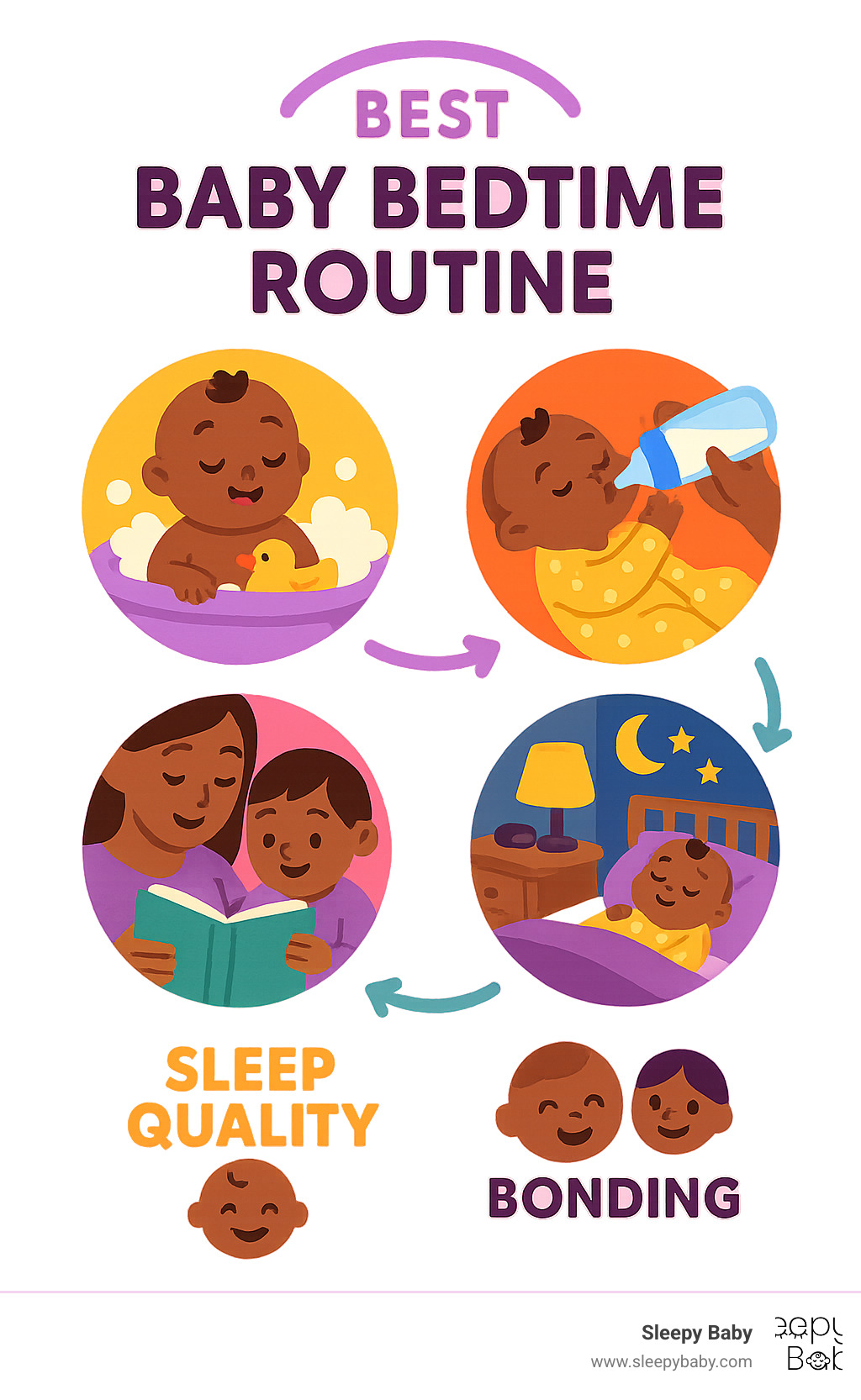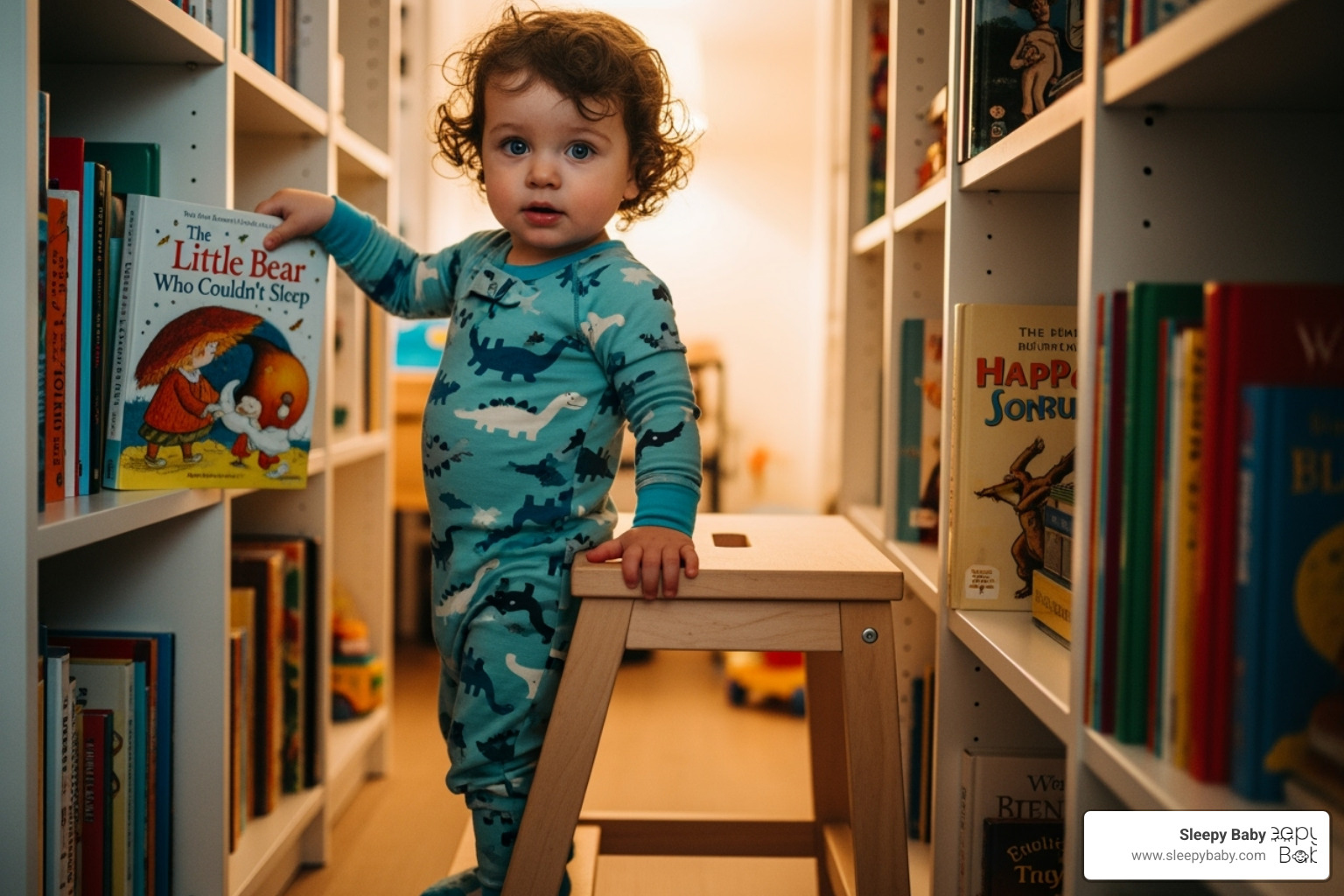Why Your Baby Needs a Bedtime Routine (And You Do Too)
The best baby bedtime routine is a consistent series of calming activities that help your little one wind down and prepare for sleep. Research shows that babies with established routines fall asleep faster, wake less during the night, and sleep longer overall. These predictable patterns reinforce your baby's natural circadian rhythm and create a sense of security, which is crucial for restful sleep.
A great routine also provides precious bonding time for you and your child. The essential elements include:
- Consistent Timing: Start 30-45 minutes before you want your baby to be asleep.
- Calming Activities: A warm bath, a final feeding at the start of the routine, reading, or singing.
- Sleep-Friendly Environment: A dark, quiet room with a cool temperature (68-72°F).
- Independent Sleep Practice: Putting your baby down drowsy but awake.
This guide will walk you through creating and adapting the best baby bedtime routine for your family, helping you steer the journey to better sleep for everyone.

Why a Bedtime Routine is Your Secret Weapon for Better Sleep
A best baby bedtime routine is a powerful tool for changing sleepless nights into peaceful slumber. It works on multiple levels to support your baby's developing sleep patterns.
- Reinforces Circadian Rhythms: Consistent timing teaches your baby's internal clock the difference between day and night.
- Provides Security: Predictability helps babies feel secure, reducing stress hormones that can interfere with sleep.
- Creates Powerful Sleep Cues: Over time, activities like a warm bath or a soft lullaby signal to your baby's brain that it's time for sleep. Research shows consistent routines improve sleep, helping babies fall asleep faster.
- Supports Brain Development: Quality sleep is essential for memory consolidation and the neural connections that fuel learning.
- Strengthens Your Bond: Quiet moments of connection create positive associations with bedtime and reduce stress for the whole family.
- Builds Independent Sleep Skills: A well-structured routine sets the stage for putting your baby down drowsy but awake, allowing them to practice self-soothing.
A consistent routine creates calm for everyone, turning a potentially stressful time into a peaceful transition. If you're facing challenges, Understanding Why Babies Fight Sleep and How to Help offers more strategies.
Getting Started: When and How to Begin Your Routine
While you can introduce simple day/night patterns from birth, the sweet spot for a more structured best baby bedtime routine is around 6 to 8 weeks of age. At this point, your baby's sleep becomes more predictable. Don't worry if you're starting with an older baby—it's never too late to benefit from consistency. For more on early habits, see From Sleepless Nights to Sweet Dreams: Establishing Newborn Sleep Patterns.
Creating the Perfect Sleep Environment
Your baby's room is key to a successful routine. Aim to create a calm, sleep-inducing space:
- Darkness: Use blackout curtains to block out all light, signaling to your baby's body that it's time to produce melatonin. Dim the lights in your home 30-45 minutes before bedtime.
- Cool Temperature: A room between 68-72°F (20-22°C) is ideal for promoting deeper sleep.
- Sound: A consistent, low-level sound can mask startling household noises. While some white noise machines can be unsafe if too loud, modern safety-rated devices present white noise at safe, low-decibel levels. Some innovative options can even be placed on your baby's chest for more effective soothing.
- Safety First: Always follow safe sleep guidelines. Place your baby on their back in a crib free of blankets, pillows, and toys. For more, see the AAP's policy: How to Keep Your Sleeping Baby Safe: AAP Policy Explained.
The Building Blocks of the Best Baby Bedtime Routine

The best baby bedtime routine moves from calm to calmer activities, gently guiding your baby toward sleep. Customize the steps based on what soothes your child, but keep the sequence consistent.
Step 1: The Calming Bath
A warm bath is a great first step. The subsequent drop in core body temperature is a natural sleep trigger, as shown by research on thermoregulation. A bath isn't needed every night; two to three times a week is fine to prevent dry skin. On other nights, a warm washcloth wipe-down works just as well.
Step 2: Hygiene and Comfort
After the bath, move on to comfort essentials: a fresh diaper and soft, temperature-appropriate pajamas. This is also a great time for a gentle massage with baby lotion, which can boost melatonin production. Don't forget oral hygiene—wipe gums with a soft cloth or gently brush new teeth.
Step 3: The Final Feed
Offer a full feeding at the beginning or middle of the routine, not the very end. This ensures a full tummy without creating a feed-to-sleep association, which is key for developing independent sleep skills. Keep the lights dim but your baby engaged enough to finish the feed before becoming too drowsy.
Step 4: Quiet Connection
These moments build your bond and signal that the day is ending. Read a simple board book, sing a familiar lullaby, or just cuddle and talk softly. The sound of your voice is incredibly soothing and builds early language skills. For age-specific ideas, see Goodnight, Sleep Tight: Bedtime Routines for Your 3-Month-Old.
Step 5: The Final Wind-Down with Sleep Aids
This last step bridges the gap from your arms to the crib.
- Swaddles and Sleep Sacks: For newborns, a snug swaddle prevents the startle reflex from waking them. Once they show signs of rolling, transition to a wearable sleep sack for warmth and safety.
- White Noise and Rhythmic Tapping: The womb is a noisy place, so many babies find consistent sound soothing. Rhythmic tapping devices can also be a game-changer, mimicking a caregiver's comforting touch. Intelligent sleep aids like those from Sleepy Baby combine these features, providing safe, low-decibel white noise and gentle patting to help your baby fall asleep independently.
- Avoid Screens: Research shows that light from phones, tablets, or TVs disrupts infant sleep. Keep all screens off for at least an hour before bedtime.
For more on effective sleep aids, explore Dreamland Awaits: Best Sleep Aids for Your Newborn.
Adapting the Routine as Your Baby Grows
The best baby bedtime routine evolves with your child. Flexibility is key to adapting to their developmental milestones.

Newborn Routine (0-3 Months)
Keep it short and simple (15-20 minutes). Focus on the basics: a diaper change, feeding, cuddling, and swaddling. The goal is comfort and establishing a simple pattern. Don't stress about perfection. For more, see Routine Magic: Creating a Newborn Schedule for Success.
Infant Routine (4-12 Months): Building the best baby bedtime routine
As circadian rhythms mature, the routine can lengthen to 25-35 minutes. Incorporate more structure with a bath, massage, story, and song. Transition from a swaddle to a sleep sack as your baby becomes mobile. This is the prime time to consistently practice putting your baby down drowsy but awake to foster independent sleep. Learn more about this stage in The Sleep Journey: Infant Sleep Patterns in the First Year.
Toddler Routine (1-3 Years)
With growing independence, the routine may last 45-60 minutes. Add practical steps like brushing teeth and potty time. Empower your toddler by offering simple choices, like which pajamas to wear or which book to read. This reduces resistance and honors their need for control. For more tips, see Toddler Bedtime Trouble: Tips for Parents.
Troubleshooting Common Bedtime Battles
Even the best baby bedtime routine will have challenging nights. Growth spurts, teething, and developmental leaps can disrupt sleep. The key is to respond with consistency, patience, and calm.
When Your Baby Fights the Routine
Resistance at bedtime is often a sign of being overtired. When a baby's wake window is too long, their body produces stress hormones that make it harder to settle. Watch for sleepy cues (yawning, eye rubbing) and start the routine before they get overtired. Less commonly, an undertired baby may also resist sleep. Separation anxiety is another common factor around 8-12 months; extra cuddles can help. For more help, read When Bedtime Turns Into Cry Time and How to Stop It.
Navigating Sleep Regressions
Sleep regressions are temporary setbacks tied to major developmental milestones, often occurring around 4, 8, and 12 months. It's a sign your baby's brain is hard at work! The best strategy is to stick to your routine as much as possible. Consistency provides security during these changes. Offer extra comfort, but try to avoid creating new sleep habits you'll have to break later. Get help with the first major regression in 4-Month-Old Sleep Schedule: Tips for Restful Nights.
The "Drowsy But Awake" Dilemma
Putting your baby down drowsy but awake is crucial for teaching them to fall asleep independently. This skill helps them self-soothe and connect sleep cycles during the night. If they cry, offer gentle reassurance with your voice or a hand on their chest before picking them up. You can also try a gradual approach, putting them down slightly more awake each night. Intelligent sleep aids that provide rhythmic patting can be a great support tool during this process. For more gentle techniques, see No More Tears: Easy Techniques to Help Your Baby Self-Soothe.
Frequently Asked Questions about the Best Baby Bedtime Routine
Here are answers to common questions about creating the best baby bedtime routine.
How long should a baby's bedtime routine be?
The ideal length changes with age:
- Newborns (0-3 months): 15-20 minutes.
- Infants (4-12 months): 25-35 minutes.
- Toddlers (1-3 years): 45-60 minutes. The consistency of the sequence is more important than the exact duration.
Should I give my baby a bath every night?
No, it's not necessary. The American Academy of Pediatrics suggests two to three baths per week is sufficient to avoid drying out your baby's delicate skin. On non-bath nights, a quick wipe-down is fine. The routine's pattern is what signals sleep, not the bath itself. For more, see the AAP's guidance on Bathing Your Baby.
What if we miss the routine one night?
It's okay! Life with a baby is unpredictable. One missed night won't undo all your progress. Don't feel guilty—just get back to your routine the next night. Consistency over time is what builds healthy sleep habits, not perfection every single night.
Conclusion
Creating the best baby bedtime routine is about building a foundation of security and calm for your entire family. It's a gift of predictable, soothing patterns that help your baby learn to rest, allowing you to reclaim your evenings.
Consistency over perfection is the goal. Your routine will evolve as your baby grows, and that flexibility is a sign of great parenting. The quiet moments of connection you share during this time are what truly matter, creating memories that last a lifetime.
At Sleepy Baby, we understand the journey to better sleep. Our intelligent sleep aids are designed to support your routine, not replace it. By providing rhythmic patting that mimics your touch and safe, low-decibel white noise, our devices offer hands-free support to help your baby learn independent sleep skills.
A great routine creates calm for the whole family. To see how the right tools can improve your efforts, Explore our newborn sleep solutions and product roundup.



